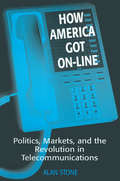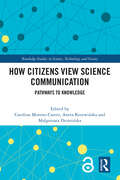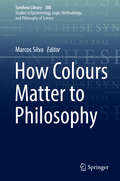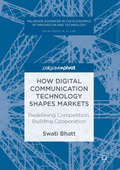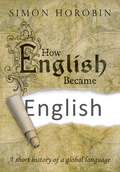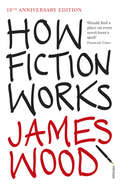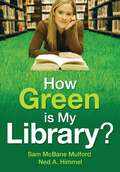- Table View
- List View
How Abstract Is It? Thinking Capital Now
by Rebecca Colesworthy Peter NichollsSince the start of the financial crisis in 2008, the notion that capitalism has become too abstract for all but the most rarefied specialists to understand has been widely presupposed. Yet even in academic circles, the question of abstraction itself – of what exactly abstraction is, and does, under financialisation – seems to have gone largely unexplored – or has it? By putting the question of abstraction centre stage, How Abstract Is It? Thinking Capital Now offers an indispensable counterpoint to the ‘economic turn’ in the humanities, bringing together leading literary and cultural critics in order to propose that we may know far more about capital’s myriad abstractions than we typically think we do. Through in-depth engagement with classic and cutting-edge theorists, agile analyses of recent Hollywood films, groundbreaking readings of David Foster Wallace’s sprawling, unfinished novel, The Pale King, and even original poems, the contributors here suggest that the machinations and costs of finance – as well as alternatives to it – may already be hiding in plain sight. This book was originally published as a special issue of Textual Practice.
How Abstract Is It? Thinking Capital Now
by Rebecca Colesworthy and Peter NichollsSince the start of the financial crisis in 2008, the notion that capitalism has become too abstract for all but the most rarefied specialists to understand has been widely presupposed. Yet even in academic circles, the question of abstraction itself – of what exactly abstraction is, and does, under financialisation – seems to have gone largely unexplored – or has it? By putting the question of abstraction centre stage, How Abstract Is It? Thinking Capital Now offers an indispensable counterpoint to the ‘economic turn’ in the humanities, bringing together leading literary and cultural critics in order to propose that we may know far more about capital’s myriad abstractions than we typically think we do. Through in-depth engagement with classic and cutting-edge theorists, agile analyses of recent Hollywood films, groundbreaking readings of David Foster Wallace’s sprawling, unfinished novel, The Pale King, and even original poems, the contributors here suggest that the machinations and costs of finance – as well as alternatives to it – may already be hiding in plain sight. This book was originally published as a special issue of Textual Practice.
How America Got On-line: Politics, Markets, and the Revolution in Telecommunication
by Alan StoneThe telecommunications industry is the fastest growing sector of the US economy. This interdisciplinary study of technopolitical economics traces the industry's evolution from the invention of the telephone to the development of hypercommunications. Primary focus is on AT&T and its rivals.
How America Got On-line: Politics, Markets, and the Revolution in Telecommunication
by Alan StoneThe telecommunications industry is the fastest growing sector of the US economy. This interdisciplinary study of technopolitical economics traces the industry's evolution from the invention of the telephone to the development of hypercommunications. Primary focus is on AT&T and its rivals.
How Bad Writing Destroyed the World: Ayn Rand and the Literary Origins of the Financial Crisis
by Adam WeinerLiterature can be used to disseminate ideas with devastating real-life consequences. In How Bad Writing Destroyed the World, Adam Weiner spans decades and continents to reveal the surprising connections between the 2008-2009 financial crisis and a relatively unknown nineteenth-century Russian author. A congressional investigation placed the blame for the financial crisis on Alan Greenspan and his deregulatory policies-his attempts, in essence, to put Ayn Rand's Objectivism into practice. Though developed most famously in Rand's Atlas Shrugged, Objectivism sprouted from the Rational Egoism of Nikolai Chernyshevsky's What Is to be Done? (1863), an enormously influential Russian novel decried by the likes of Fyodor Dostoevsky and Vladimir Nabokov for its destructive radical ethics. In tracing the origins of Greenspan's ruinous ideology, How Bad Writing Destroyed the World combines literary and intellectual history to uncover the danger of hawking “the virtues of selfishness,” even in fiction.
How Bad Writing Destroyed the World: Ayn Rand and the Literary Origins of the Financial Crisis
by Adam WeinerLiterature can be used to disseminate ideas with devastating real-life consequences. In How Bad Writing Destroyed the World, Adam Weiner spans decades and continents to reveal the surprising connections between the 2008-2009 financial crisis and a relatively unknown nineteenth-century Russian author. A congressional investigation placed the blame for the financial crisis on Alan Greenspan and his deregulatory policies-his attempts, in essence, to put Ayn Rand's Objectivism into practice. Though developed most famously in Rand's Atlas Shrugged, Objectivism sprouted from the Rational Egoism of Nikolai Chernyshevsky's What Is to be Done? (1863), an enormously influential Russian novel decried by the likes of Fyodor Dostoevsky and Vladimir Nabokov for its destructive radical ethics. In tracing the origins of Greenspan's ruinous ideology, How Bad Writing Destroyed the World combines literary and intellectual history to uncover the danger of hawking “the virtues of selfishness,” even in fiction.
How Citizens View Science Communication: Pathways to Knowledge (Routledge Studies in Science, Technology and Society)
by Carolina Moreno-Castro Aneta Krzewińska Małgorzata DzimińskaScience communication aims at the successful sharing and explanation of sciencerelated topics to a wider audience. In order to enhance communication between science and society, a better understanding of citizens’ habits and perceptions is needed. Therefore, it is vital to understand how citizens acquire knowledge about science- related issues, how this knowledge affects their beliefs, opinions and perceptions, and what sources of information they choose to learn about science – and how they assess their reliability. This book addresses these questions, based on the analyses of public consultations data from Italy, Poland, Portugal, Slovakia and Spain, concerned with the science communication of issues including climate change, vaccines, complementary and alternative medicine (CAM) and genetically modified organisms (GMOs). Sharing experiences of how to engage citizens in public consultation, it provides insights into the mobilisation of interest in science and offers recommendations on how to improve science communication.
How Citizens View Science Communication: Pathways to Knowledge (Routledge Studies in Science, Technology and Society)
Science communication aims at the successful sharing and explanation of sciencerelated topics to a wider audience. In order to enhance communication between science and society, a better understanding of citizens’ habits and perceptions is needed. Therefore, it is vital to understand how citizens acquire knowledge about science- related issues, how this knowledge affects their beliefs, opinions and perceptions, and what sources of information they choose to learn about science – and how they assess their reliability. This book addresses these questions, based on the analyses of public consultations data from Italy, Poland, Portugal, Slovakia and Spain, concerned with the science communication of issues including climate change, vaccines, complementary and alternative medicine (CAM) and genetically modified organisms (GMOs). Sharing experiences of how to engage citizens in public consultation, it provides insights into the mobilisation of interest in science and offers recommendations on how to improve science communication.
How Colours Matter to Philosophy (Synthese Library #388)
by Marcos SilvaThis edited volume explores the different and seminal ways colours matter to philosophy. Each chapter provides an insightful analysis of one or more cases in which colours raise philosophical problems in different areas and periods of philosophy. This historically informed discussion examines both logical and linguistic aspects, covering such areas as the mind, aesthetics and the foundations of mathematics. The international contributors look at traditional epistemological and metaphysical issues on the subjectivity and objectivity of colours. In addition, they also assess phenomenological problems typical of the continental tradition and contemporary problems in the philosophy of mind. The chapters include coverage of such topics as Newton’s and Goethe’s theory of light and colours, how primary qualities are qualitative and colours are primary, explaining colour phenomenology, and colour in cognition, language and philosophy. "This book beautifully prepares the ground for the next steps in our research on and philosophising about colour" Daniel D. Hutto (University of Wollongong)"It is not an overstatement to say that How Colours to Philosophy is a ground breaking publication" Mazviita Chirimuuta (University of Pittsburgh)"Anyone interested in philosophical issues about color will find it highly stimulating." Martine Nida-Rümelin (Université de Fribourg)"The high quality papers included in this anthology succeed admirably in enriching current philosophical thinking about colour” Erik Myin (University of Antwerp)“This is certainly the most complete collection of philosophical essays on colours ever published” André Leclerc (University of Brasília)“All in all this collections represents a new milestone in the ongoing philosophical debate on colours and colour expressions” Ingolf Max (University of Leipzig)
How Dark Is My Flower: Yosano Akiko and the Invention of Romantic Love (Michigan Monograph Series in Japanese Studies #98)
by Leith MortonThe poetry of Yosano Akiko covers all the many and varied aspects of the experience of love—from early romantic encounters between the lover and beloved to the intimate pleasures of mutual infatuation and then true love. The journey outlined in Akiko’s verse also grapples with jealousy and unrequited passion, as Akiko’s poem-narrative treats the rivalry between herself and her best friend, the poet Yamakawa Tomiko, for the affection of the dashing young literary lion, Yosano Tekkan, who later became Akiko’s husband. Thus, How Dark Is My Flower: Yosano Akiko and the Invention of Romantic Love tells a number of stories: a real-life romance unfolds in the poetry of these three poets examined in the book, as well as the story of the journey from romanticism to modernism undertaken by early 20th century Japanese poetry. How Dark Is My Flower emphasizes the astonishing innovations in diction and style, not to mention content, in Akiko’s work that transformed the tanka genre from a hidebound and conservative mode of verse to something much more daring and modern. This book pays particular attention to poetry, particularly the tanka genre, in the evolution of modernism in Japanese literature and breaks new ground in the study of modern Japanese literature by examining the invention and evolution of the concept of romantic love.
How Dead Languages Work
by Coulter H. GeorgeWhat could Greek poets or Roman historians say in their own language that would be lost in translation? After all, different languages have different personalities, and this is especially clear with languages of the ancient and medieval world. This volume celebrates six such languages - Ancient Greek, Latin, Old English, Sanskrit, Old Irish, and Biblical Hebrew - by first introducing readers to their most distinctive features, then showing how these linguistic traits play out in short excerpts from actual ancient texts. It explores, for instance, how Homer's Greek shows signs of oral composition, how Horace achieves striking poetic effects through interlaced word order in his Latin, and how the poet of Beowulf attains remarkable intensity of expression through the resources of Old English. But these are languages that have shared connections as well. Readers will see how the Sanskrit of the Rig Veda uses words that come from roots found also in English, how turns of phrase characteristic of the Hebrew Bible found their way into English, and that even as unusual a language as Old Irish still builds on common Indo-European linguistic patterns. Very few people have the opportunity to learn these languages, and they can often seem mysterious and inaccessible: drawing on a lucid and engaging writing style and with the aid of clear English translations throughout, this book aims to give all readers, whether scholars, students, or interested novices, an aesthetic appreciation of just how rich and varied they are.
How Dead Languages Work
by Coulter H. GeorgeWhat could Greek poets or Roman historians say in their own language that would be lost in translation? After all, different languages have different personalities, and this is especially clear with languages of the ancient and medieval world. This volume celebrates six such languages - Ancient Greek, Latin, Old English, Sanskrit, Old Irish, and Biblical Hebrew - by first introducing readers to their most distinctive features, then showing how these linguistic traits play out in short excerpts from actual ancient texts. It explores, for instance, how Homer's Greek shows signs of oral composition, how Horace achieves striking poetic effects through interlaced word order in his Latin, and how the poet of Beowulf attains remarkable intensity of expression through the resources of Old English. But these are languages that have shared connections as well. Readers will see how the Sanskrit of the Rig Veda uses words that come from roots found also in English, how turns of phrase characteristic of the Hebrew Bible found their way into English, and that even as unusual a language as Old Irish still builds on common Indo-European linguistic patterns. Very few people have the opportunity to learn these languages, and they can often seem mysterious and inaccessible: drawing on a lucid and engaging writing style and with the aid of clear English translations throughout, this book aims to give all readers, whether scholars, students, or interested novices, an aesthetic appreciation of just how rich and varied they are.
How Digital Communication Technology Shapes Markets: Redefining Competition, Building Cooperation
by Swati BhattThis Palgrave Pivot explores how communication technology such as the Internet has changed the nature of trade, focusing especially on economy-wide reductions in company size (granularity) and the role of retailers (disintermediation). By increasing access to comparative data, influencing conceptions of time, and reducing the number of intermediaries between creator and consumer, technological connectivity is changing the very definition of competition. In the new network economy, disintermediation and granularity are turning cooperative information gathering and sharing into a vital market institution.To exemplify the effects of communication technology, Bhatt focuses on two markets with particularly powerful effects on the economy: labor and education, and CIME (communication, information services, media, and entertainment). Mobile connectivity is radically changing the extent, capabilities, and operations of these markets, both in terms of the services they provide and how they interact with consumers. Bhatt also explores how these benefits intersect with new concerns about privacy and security when the line between public and private information is becoming ever more fluid.
How Digital Communication Technology Shapes Markets: Redefining Competition, Building Cooperation
by Swati BhattThis Palgrave Pivot explores how communication technology such as the Internet has changed the nature of trade, focusing especially on economy-wide reductions in company size (granularity) and the role of retailers (disintermediation). By increasing access to comparative data, influencing conceptions of time, and reducing the number of intermediaries between creator and consumer, technological connectivity is changing the very definition of competition. In the new network economy, disintermediation and granularity are turning cooperative information gathering and sharing into a vital market institution.To exemplify the effects of communication technology, Bhatt focuses on two markets with particularly powerful effects on the economy: labor and education, and CIME (communication, information services, media, and entertainment). Mobile connectivity is radically changing the extent, capabilities, and operations of these markets, both in terms of the services they provide and how they interact with consumers. Bhatt also explores how these benefits intersect with new concerns about privacy and security when the line between public and private information is becoming ever more fluid.
How Education Policy Shapes Literacy Instruction: Understanding the Persistent Problems of Policy and Practice
by Rachael GabrielReading instruction is the most legislated area of education and the most frequently referenced metric for measuring educational progress. This book traces the trajectories of policy issues with direct implications for literacy teaching, learning, and research in order to illustrate the dynamic relationships between policy, research, and practice as they relate to perennial issues such as: retention in grade, remediation, intervention, instruction for English learners, early literacy instruction, coaching, and leadership. Using policy documents and peer-reviewed articles published from the 1960s to the present, the editor and authors illustrate how issues were framed, what was at stake, and how policy solutions to persistent questions have been understood over time. In doing so, the book link a generation of scholars with research that illustrates trajectories of development for ideas, strategies, and solutions.
How Empire Shaped Us
by Antoinette Burton Dane KennedyFew historical subjects have generated such intense and sustained interest in recent decades as Britain's imperial past. What accounts for this preoccupation? Why has it gained such purchase on the historical imagination? How has it endured even as its subject slips further into the past?In seeking to answer these questions, the proposed volume brings together some of the leading figures in the field, historians of different generations, different nationalities, different methodological and theoretical perspectives and different ideological persuasions. Each addresses the relationship between their personal development as historians of empire and the larger forces and events that helped to shape their careers. The result is a book that investigates the connections between the past and the present, the private and the public, the professional practices of historians and the political environments within which they take shape. This intellectual genealogy of the recent historiography of empire will be of great value to anyone studying or researching in the field of imperial history.
How Empire Shaped Us
by Antoinette Burton Dane KennedyFew historical subjects have generated such intense and sustained interest in recent decades as Britain's imperial past. What accounts for this preoccupation? Why has it gained such purchase on the historical imagination? How has it endured even as its subject slips further into the past?In seeking to answer these questions, the proposed volume brings together some of the leading figures in the field, historians of different generations, different nationalities, different methodological and theoretical perspectives and different ideological persuasions. Each addresses the relationship between their personal development as historians of empire and the larger forces and events that helped to shape their careers. The result is a book that investigates the connections between the past and the present, the private and the public, the professional practices of historians and the political environments within which they take shape. This intellectual genealogy of the recent historiography of empire will be of great value to anyone studying or researching in the field of imperial history.
How English Became English: A short history of a global language
by Simon HorobinThe English Language is spoken by more than a billion people throughout the world. But where did English come from? And how has it evolved into the language used today? In How English Became English Simon Horobin investigates the evolution of the English language, examining how the language continues to adapt even today, as English continues to find new speakers and new uses. Engaging with contemporary concerns about correctness, Horobin considers whether such changes are improvements, or evidence of slipping standards. What is the future for the English Language? Will Standard English continue to hold sway, or are we witnessing its replacement by newly emerging Englishes?
How English Became English: A short history of a global language
by Simon HorobinThe English Language is spoken by more than a billion people throughout the world. But where did English come from? And how has it evolved into the language used today? In How English Became English Simon Horobin investigates the evolution of the English language, examining how the language continues to adapt even today, as English continues to find new speakers and new uses. Engaging with contemporary concerns about correctness, Horobin considers whether such changes are improvements, or evidence of slipping standards. What is the future for the English Language? Will Standard English continue to hold sway, or are we witnessing its replacement by newly emerging Englishes?
How English Became the Global Language
by D. NorthrupIn this book, the first written about the globalization of the English language by a professional historian, the exploration of English's global ascendancy receives its proper historical due. This brief, accessible volume breaks new ground in its organization, emphasis on causation, and conclusions.
How Fiction Works
by James WoodIn the tradition of E. M. Forster's Aspects of the Novel and Milan Kundera's The Art of the Novel, How Fiction Works is a scintillating and searching study of the main elements of fiction, such as narrative, detail, characterization, dialogue, realism, and style. In his first full-length book of criticism, one of the most prominent critics of our time takes the machinery of story-telling apart to ask a series of fundamental questions: What do we mean when we say we 'know' a fictional character? What constitutes a 'telling' detail? When is a metaphor successful? Is realism realistic? Why do most endings of novels disappoint?Wood ranges widely, from Homer to Beatrix Potter, from the Bible to John Le Carré, and his book is both a study of the techniques of fiction-making and an alternative history of the novel. Playful and profound, it incisively sums up two decades of bold, often controversial, and now classic critical work, and will be enlightening to writers, readers, and anyone interested in what happens on the page.
How Gender Shapes the World
by Alexandra Y. AikhenvaldThis is a book about the multi-faceted notion of gender. Gender differences form the basis for family life, patterns of socialization, distribution of tasks, and spheres of responsibilities. The way gender is articulated shapes the world of individuals, and of the societies they live in. Gender has three faces: Linguistic Gender-the original sense of 'gender'-is a feature of many languages and reflects the division of nouns into grammatical classes or genders (feminine, masculine,This is a book about the multi-faceted notion of gender. Gender differences form the basis for family life, patterns of socialization, distribution of tasks, and spheres of responsibilities. The way gender is articulated shapes the world of individuals, and of the societies they live in. Gender has three faces: Linguistic Gender-the original sense of 'gender'-is a feature of many languages and reflects the division of nouns into grammatical classes or genders (feminine, masculine, neuter, and so on); Natural Gender, or sex, refers to the division of animates into males and females; and Social Gender reflects the social implications and norms of being a man or a woman (or perhaps something else). Women and men may talk and behave differently, depending on conventions within the societies they live in, and their role in language maintenance can also vary. The book focuses on how gender in its many guises is reflected in human languages, how it features in myths and metaphors, and the role it plays in human cognition. Examples are drawn from all over the world, with a special focus on Aikhenvald's extensive fieldwork in Amazonia and New Guinea.
How Generations Remember: Conflicting Histories and Shared Memories in Post-War Bosnia and Herzegovina (Global Diversities)
by Monika PalmbergerThis book is open access under a CC BY 4.0 license.This book provides a profound insight into post-war Mostar, and the memories of three generations of this Bosnian-Herzegovinian city. Drawing on several years of ethnographic fieldwork, it offers a vivid account of how personal and collective memories are utterly intertwined, and how memories across the generations are reimagined and ‘rewritten’ following great socio-political change. Focusing on both Bosniak-dominated East Mostar and Croat-dominated West Mostar, it demonstrates that, even in this ethno-nationally divided city with its two divergent national historiographies, generation-specific experiences are crucial in how people ascribe meaning to past events. It argues that the dramatic and often brutal transformations that Bosnia and Herzegovina has witnessed have led to alterations in memory politics, not to mention disparities in the life situations faced by the different generations in present-day post-war Mostar. This in turn has created variations in memories along generational lines, which affect how individuals narrate and position themselves in relation to the country's history. This detailed and engaging work will appeal to students and scholars of anthropology, sociology, political science, history and oral history, particularly those with an interest in memory, post-socialist Europe and conflict studies.
How Green is My Library? (Non-ser.)
by Sam McBane Mulford Ned A. HimmelWhile there is a broad spectrum of ecological sophistication within libraries nationwide and some regions are at the forefront of sustainable of sustainable design and operations, others are just beginning or have yet to integrate materials recycling into their daily practice. A few jurisdictions are mandating LEED certified buildings and carbon-neutral practices, while others do not yet have these concepts on their radars.

